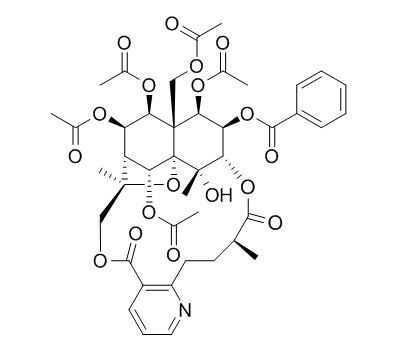Wilforine
Wilforine has anti-inflammatory effect, which might be mediated by down-regulation of the expression of inflammatory factors TNF-α, IL-6 and NO. It also has insecticidal activity by inhibiting the Na+-K+-ATPase in the central nervous system.
Inquire / Order:
manager@chemfaces.com
Technical Inquiries:
service@chemfaces.com
Tel:
+86-27-84237783
Fax:
+86-27-84254680
Address:
1 Building, No. 83, CheCheng Rd., Wuhan Economic and Technological Development Zone, Wuhan, Hubei 430056, PRC
Providing storage is as stated on the product vial and the vial is kept tightly sealed, the product can be stored for up to
24 months(2-8C).
Wherever possible, you should prepare and use solutions on the same day. However, if you need to make up stock solutions in advance, we recommend that you store the solution as aliquots in tightly sealed vials at -20C. Generally, these will be useable for up to two weeks. Before use, and prior to opening the vial we recommend that you allow your product to equilibrate to room temperature for at least 1 hour.
Need more advice on solubility, usage and handling? Please email to: service@chemfaces.com
The packaging of the product may have turned upside down during transportation, resulting in the natural compounds adhering to the neck or cap of the vial. take the vial out of its packaging and gently shake to let the compounds fall to the bottom of the vial. for liquid products, centrifuge at 200-500 RPM to gather the liquid at the bottom of the vial. try to avoid loss or contamination during handling.
Int J Mol Sci.2020, 21(9):3144.
Plant Physiol Biochem.2023, 203:108073.
Saudi Pharm J.2019, 27(1):145-153
Sci Rep.2023, 13(1):14594.
Food Funct.2021, 12(4):1469-1481.
J Food Compos Anal2017, 62:197-204
J. Soc. Cosmet. Sci. Korea2016, 163-171
Toxicol Rep.2021, 8:1131-1142.
Front Mol Neurosci.2023, 15:1083189.
International Food Research Journal2018, 25(6):2560-2571
Related and Featured Products
J Microbiol Biotechnol. 2014 Jun 28;24(6):823-34.
Establishment of Tripterygium wilfordii Hook. f. Hairy root culture and optimization of its culture conditions for the production of triptolide and wilforine.[Pubmed:
24651642]
METHODS AND RESULTS:
In order to solve the shortage of natural Tripterygium wilfordii Hook. f. plant resource for the production of the important secondary metabolites triptolide and Wilforine, hairy roots were induced from its root calli by Agrobacterium rhizogenes.
Induced hairy roots not only could be maintained and grown well in hormone-free half-strength Murashige and Skoog medium but also could produce sufficient amounts of both triptolide and Wilforine. Although hairy roots produced approximately 15% less triptolide than adventitious roots and 10% less Wilforine than naturally grown roots, they could grow fast and could be a suitable system for producing both secondary metabolites compared with other tissues. Addition of 50 micrometer methyl jasmonate (MeJA) could slightly affect hairy root growth, but dramatically stimulated the production of both triptolide and Wilforine, whereas 50 micrometer salicylic acid had no apparent effect on hairy root growth with slightly stimulatory effects on the production of both secondary metabolites. Addition of precursor nicotinic acid, isoleucine, or aspartic acid at the concentration of 500 micrometer had varying effects on hairy root growth, but none of them had stimulatory effects on triptolide production, and only the former two had slightly beneficial effects on Wilforine production. The majority of triptolide produced was secreted into the medium, whereas most of the produced Wilforine was retained inside of hairy roots.
CONCLUSIONS:
Our studies provide a promising way to produce triptolide and Wilforine in T. wilfordii hairy root cultures combined with MeJA treatment.
Biomed Chromatogr. 2015 Jul;29(7):1042-7.
Application of a sensitive and specific LC-MS/MS method for determination of wilforine from Tripterygium wilfordii Hook. F. in rat plasma for a bioavailability study.[Pubmed:
25425175]
METHODS AND RESULTS:
A highly selective and specific LC-MS/MS method was developed and validated for the determination of Wilforine in rat plasma. The analyte was separated from plasma matrix by using methyl tertiary butyl ether liquid-liquid extraction with bulleyacinitine A as internal standard (IS). The analysis was carried out on a Sepax GP-Phenyl column using a mixture of methanol and 10 mmol/L ammonium formate buffer solution containing 0.1% formic acid (75:25, v/v) as the mobile phase pumped at a flow rate of 1.0 mL/min. The detection was operated using a triple-quadrupole mass spectrometer in multiple selected reaction monitoring with the parent-to-product quantifier transitions [M + H]+ m/z 867.6 →206.0 for Wilforine and 664.1 →584.1 for IS. The main advantage of this method was the high sensitivity (a lower limit of quantification of 0.02 ng/mL) and the small amount of sample (0.1 mL plasma per sample).
CONCLUSIONS:
The method was fully validated to be accurate and precise with a linear range of 0.02-100 ng/mL, and successfully applied to a bioavailability study of Wilforine in rats after intravenous and oral administration. The oral absolute bioavailability of Wilforine in rats was estimated to be 84%.



